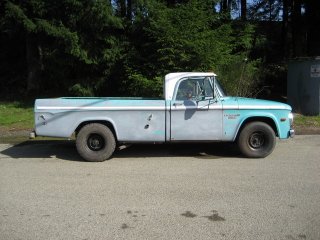| Subject: |
|
Re: Shop Floor |
| Name: |
|
MoparNorm |
| Date Posted: |
|
Mar 29, 07 - 7:40 AM |
| IP Address: |
|
71.110.253.134 |
| Email: |
|
moparnorm@hotmail.com |
| Message: |
|
Like Terry said, you have to give them a mix design. Unless you are so far from a city that the "Batch Plant" is independently run by what we call here an "outlaw", then the plant will conform to Industry standards, have an on site Deputy Inspector and certify all loads.
Depending upon what you want to achieve (permit job, or a specific design strength) you can call up the order desk and request a specific design mix or ask them to give you a design mix to conform to your specifications. You do have to be careful though because if the plant is unscrupulous or they have waste product (fly-ash) that they are trying to unload, they will give you a mix design that benefits them and not you.
Here are some basic questions to ask yourself, before you order.
What are you using the shop for? Heavy equipment or just trucks? Heavy equipment (tractors, loaders, dump trucks, etc. need a 6" thick slab of at least 3,000 psi. That translates to a 3/4" minimum rock size, 6 sack mix (that's 6 sacks of cement per yard of concrete) and a slump of 4 inches.
For our trucks and light equipment, a minimum would be a 2,500 psi slab of 5" thick. That translates to 3/4" rock, 5.5 sacks cement per yard, with a slump of 5 inches.
In either case the "Slump" is the key. Slump translates to the amount of water added to a slab, minimum water is the key. Every legit plant with have a certified mix that meets your design criteria. The Deputy Inspector or Weight Master at the Batch Plant will certify the load, and right on the ticket will be the weight per yard of the cement, the sand and the aggregate (rock). It will tell you how much water was added and how much allowable water can be added at the job site. ANY ADDITIONAL water added will RUIN the batch and cause cracking, either hundreds of small surface cracks or major cracks that go all the way through the slab. Water is a killer for concrete, it dilutes the mix design. Placing concrete is hard work and the finishers love an easy day, it they were allowed to add water they put 30 gallons per yard as it makes it easier to place and finish, it also gives you thousands of dollars worth of sand slurry, a slab that is junk. The higher the slump, the weaker the mix.
So you need a proper design mix, and competent finishers to get a good slab.
FYI: The typical tract house uses a 2,000 psi mix with a 5 sack mix. You don't want that. The difference between a 5 sack mix and a 6 sack mix is only about $8 per yard, also make sure that it is a 6 sack mix and NOT a six sack "equivalent", that means they charge you for 6 sacks but they use 4 sacks of cement and 2 sacks of fly-ash or some other cement by-product that they acquired cheap. Cracking can be caused by too much water, too thin of a slab, poor compaction in the sub grade under the slab, the type of soil under the slab and improper use of reinforcing steel.
Good Luck! |
|
Replies:
|
|
|
|
|










 Reply
Reply Home
Home bravenet.com
bravenet.com